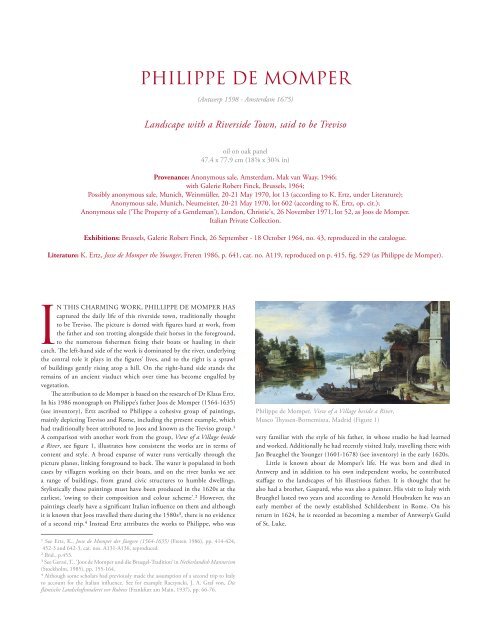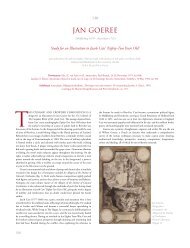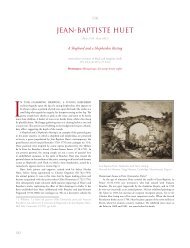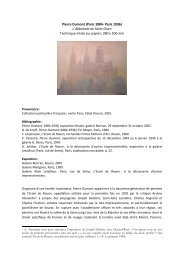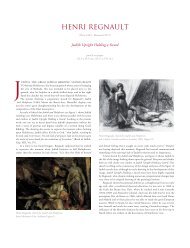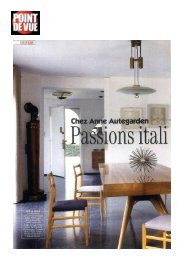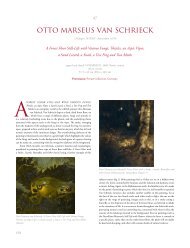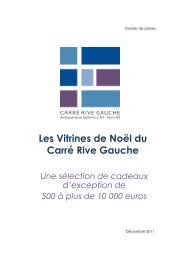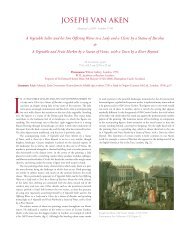PHILIPPE DE MOMPER
PHILIPPE DE MOMPER
PHILIPPE DE MOMPER
Create successful ePaper yourself
Turn your PDF publications into a flip-book with our unique Google optimized e-Paper software.
in this charming work, PhilliPPe de momPer has<br />
captured the daily life of this riverside town, traditionally thought<br />
to be treviso. The picture is dotted with figures hard at work, from<br />
the father and son trotting alongside their horses in the foreground,<br />
to the numerous fishermen fixing their boats or hauling in their<br />
catch. The left-hand side of the work is dominated by the river, underlying<br />
the central role it plays in the figures’ lives, and to the right is a sprawl<br />
of buildings gently rising atop a hill. on the right-hand side stands the<br />
remains of an ancient viaduct which over time has become engulfed by<br />
vegetation.<br />
The attribution to de momper is based on the research of dr klaus ertz.<br />
in his 1986 monograph on Philippe’s father Joos de momper (1564-1635)<br />
(see inventory), ertz ascribed to Philippe a cohesive group of paintings,<br />
mainly depicting treviso and rome, including the present example, which<br />
had traditionally been attributed to Joos and known as the treviso group.¹<br />
a comparison with another work from the group, View of a Village beside<br />
a River, see figure 1, illustrates how consistent the works are in terms of<br />
content and style. a broad expanse of water runs vertically through the<br />
picture planes, linking foreground to back. The water is populated in both<br />
cases by villagers working on their boats, and on the river banks we see<br />
a range of buildings, from grand civic structures to humble dwellings.<br />
stylistically these paintings must have been produced in the 1620s at the<br />
earliest, ‘owing to their composition and colour scheme’.² however, the<br />
paintings clearly have a significant italian influence on them and although<br />
it is known that Joos travelled there during the 1580s³, there is no evidence<br />
of a second trip.⁴ instead ertz attributes the works to Philippe, who was<br />
<strong>PHILIPPE</strong> <strong>DE</strong> <strong>MOMPER</strong><br />
(Antwerp 1598 - Amsterdam 1675)<br />
Landscape with a Riverside Town, said to be Treviso<br />
oil on oak panel<br />
47.4 x 77.9 cm (18⅝ x 30¾ in)<br />
Provenance: anonymous sale, amsterdam, mak van waay, 1946;<br />
with galerie robert Finck, Brussels, 1964;<br />
Possibly anonymous sale, munich, weinmüller, 20-21 may 1970, lot 13 (according to k. ertz, under literature);<br />
anonymous sale, munich, neumeister, 20-21 may 1970, lot 602 (according to k. ertz, op. cit.);<br />
anonymous sale (‘The Property of a gentleman’), london, christie's, 26 november 1971, lot 52, as Joos de momper.<br />
italian Private collection.<br />
Exhibitions: Brussels, galerie robert Finck, 26 september - 18 october 1964, no. 43, reproduced in the catalogue.<br />
Literature: k. ertz, Josse de Momper the Younger, Freren 1986, p. 641, cat. no. a119, reproduced on p. 415, fig. 529 (as Philippe de momper).<br />
¹ see ertz, k., Josse de Momper der Jüngere (1564-1635) (Freren 1986), pp. 414-424,<br />
452-3 and 642-3, cat. nos. a131-a136, reproduced<br />
² ibid., p.453.<br />
³ see gerzsi, t., ‘Joos de momper und die Bruegel-tradition’ in Netherlandish Mannerism<br />
(stockholm, 1985), pp. 155-164.<br />
⁴ although some scholars had previously made the assumption of a second trip to italy<br />
to account for the italian influence. see for example raczyncki, J. a. graf von, Die<br />
flämische Landschaftsmalerei vor Rubens (Frankfurt am main, 1937), pp. 66-76.<br />
Philippe de momper, View of a Village beside a River,<br />
museo Thyssen-Bornemisza, madrid (Figure 1)<br />
very familiar with the style of his father, in whose studio he had learned<br />
and worked. additionally he had recently visited italy, travelling there with<br />
Jan Brueghel the Younger (1601-1678) (see inventory) in the early 1620s.<br />
little is known about de momper’s life. he was born and died in<br />
antwerp and in addition to his own independent works, he contributed<br />
staffage to the landscapes of his illustrious father. it is thought that he<br />
also had a brother, gaspard, who was also a painter. his visit to italy with<br />
Brueghel lasted two years and according to arnold houbraken he was an<br />
early member of the newly established schildersbent in rome. on his<br />
return in 1624, he is recorded as becoming a member of antwerp’s guild<br />
of st. luke.


